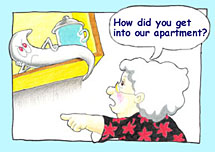Grammar: Sentence: Quoting and reporting speech and thoughts
| Quoting speech and thoughts |
Structure of direct speech
We use 'direct speech' when we wish to report what someone has said by quoting the actual words used. We can also use direct speech for quoting thoughts. Sometimes a speaker quotes their own thinking as if they were speaking, for example when a speaker says, I said to myself, "I must find out what happened." This is often called 'thinking aloud'.
The typical structure of direct speech is a complex sentence (or clause complex) made up of two parts: a 'quoting clause' and a 'quoted clause' (ie the quote or quotation itself):
| Granny Gong asked, quoting clause "GrumpyGhost, did you come through the door?" |
 |
| "This looks like a job for Granny Gong!" quoted clause thought
Miss Lee. |
 |
The quotation is indicated by quotation marks (also called 'inverted commas') that enclose the quoted words.
The quoting clause may precede or follow the quoted clause:
|
Granny said, "I don't believe
you!" "I don't believe you!" Granny said. |
If the quoting clause follows the quoted clause, the order of noun and verb expressing the speaker and the process of speaking in the quoting clause (Granny said) may be reversed with some verbs, most commonly with say:
| "I don't believe you!" said Granny. quoted clause quoting clause |
This order is possible if the speaker is expressed by a noun, but not when it is expressed by a pronoun (except in poetic English):
|
|
The quoting clause may also be enclosed inside the quoted clause:
| "GrumpyGhost," quoted clause ... she said, "how did
you get into our apartment?" |
 |
Features of direct speech
Here is a brief summary of the main features of direct speech:
| Punctuation | ||
| comma or colon after the quoting clause: | ||
Bozo asked his friend, "Where ...?"or Bozo asked his friend: "Where ...?" |
||
| quoted clause enclosed in inverted commas (single or double): | ||
"Where has Miss Lee gone?"or 'Where has Miss Lee gone?' |
||
| upper case initial for the first word of the quoted clause: | ||
"Wherehas Miss Lee gone?" |
||
| Grammar | ||
| tense of the actual spoken words is unchanged in the quoted clause: | ||
Scene: Ricky is talking to Bozo and asks him where he went. |
||
| normal word order for clause type is retained in the quoted clause: | ||
declarative (Statement), eg "Mr Gong is working late today." |
||
interrogative (Question), eg "Is Mr Gong working late today?" |
||
imperative (Command), eg "Be quiet!" |
||
| pronoun used in the actual spoken words is also used in quoted clause: | ||
Bozo asks his friend, "Where have you been?" |
||
|
Alternative terms |
|
| PrimeGram | Other grammars |
| clause | simple sentence |
| clause complex | sentence, compound sentence, complex sentence |
| quoting | direct speech |
| reporting | indirect speech |
Tell me more ... Punctuating direct speech |
|
||
To give us feedback about this section, click here or on the Comment button at the top of the screen.
If you have any questions about this section, visit the Language Corner.
If you have any questions or suggestions about how to teach this section, send a message to the Teaching Corner.